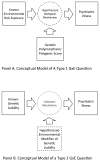Gene-environment interaction research in psychiatric epidemiology: a framework and implications for study design
- PMID: 25216778
- PMCID: PMC4174337
- DOI: 10.1007/s00127-014-0954-5
Gene-environment interaction research in psychiatric epidemiology: a framework and implications for study design
Conflict of interest statement
Figures

Comment on
-
Gene-environment interactions in common mental disorders: an update and strategy for a genome-wide search.Soc Psychiatry Psychiatr Epidemiol. 2014 Jan;49(1):3-14. doi: 10.1007/s00127-013-0801-0. Epub 2013 Dec 10. Soc Psychiatry Psychiatr Epidemiol. 2014. PMID: 24323294
References
Publication types
MeSH terms
Grants and funding
- G9806489/MRC_/Medical Research Council/United Kingdom
- G0601483/MRC_/Medical Research Council/United Kingdom
- R01 HD077482/HD/NICHD NIH HHS/United States
- HD077482/HD/NICHD NIH HHS/United States
- HD061298/HD/NICHD NIH HHS/United States
- MR/K00381X/1/MRC_/Medical Research Council/United Kingdom
- R01 HD061298/HD/NICHD NIH HHS/United States
- G0100527/MRC_/Medical Research Council/United Kingdom
- T32 AG000029/AG/NIA NIH HHS/United States
- R01 AG032282/AG/NIA NIH HHS/United States
- L60 MD007327/MD/NIMHD NIH HHS/United States
- AG032282/AG/NIA NIH HHS/United States
- P30 AG028716-08/AG/NIA NIH HHS/United States
- T32-AG00029/AG/NIA NIH HHS/United States
- P30 AG028716/AG/NIA NIH HHS/United States
LinkOut - more resources
Full Text Sources
Other Literature Sources
Medical

